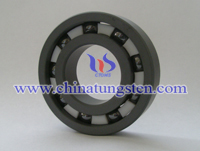
The tungsten carbide bearing inserted tungsten carbide adopts the advance technology with the high strength and long life features. The cemented carbide bearing surface with the cemented carbide material, special solder and welded to a whole body with the basis part through sinter treatment, makes the cemented carbide bearing with the high strength, long life, anti-wear, anti-impact and high load. The standard bearing used is a Carbon-Graphite compound which has excellent corrosion resistant characteristics when operating in most liquid environments. Certain fluids will attack the binder or process streams may contain abrasive solids which preclude the use of carbon-graphite bearing. In these cases alternate materials are available such as:
A brief description of each of these tungsten carbide bearings materials.
These are materials manufactured from a blending of Carbon and Graphite powders with a hydrocarbon binder. The result is a materials which is resistant to wear, chemically resistant and thermally stable. There are many grades of Carbon-Graphite bearing materials. The shaft journal treatments M-2, M-3 or NCB can be used with type B bearings although it is not necessary. Journal treatment will extend the life of the shaft since it will resist abrasion if the bearings run dry or are exposed to abrasive particles. See Engineering data sheet 26E for more informationconcerning shaft coatings. When a tungsten carbide bearing wear detector is used, the maximum fluid temperature for a sleeved, bearing is 400°F.
This material is a self sintered, high density hardened material with very good wear and chemical resistance. Silicon carbide is very wear resistance but care must be taken when applying this material because silicon carbide is brittle making it susceptible to thermal and mechanical shock. This type of cemented carbide bearing is much less forgiving than carbon graphite when system upsets, such as dry running and cavitation, occur. Silicon graphite bearings do not wear gradually. If the bearings fail they normally shatter into many pieces causing a catastrophic failure.
CARBON-GRAPHITE - This is a grade of Carbon-Graphite which is used primarily in Hydrofluoric Acid service. Experience has shown that the binder of the carbon graphite type B bearings is attacked by hydrofluoric acid causing the bearing to swell and seize on the shaft. The type F-2 graphite composition is inert to hydrofluoric acid attack.
This grade can be used on other applications, but most are covered by the Type B bearing which is less expensive and more readily available. Run dry or are exposed to abrasive particles. See Engineering data sheet 26E for more information concerning shaft coatings.
This material is very similar to silicon carbide with regard to wear and chemical resistance. Aluminum oxide is also very susceptible to thermal and mechanical shock.
More Info>>
1.Tungsten Carbide
2.Tungsten carbide Bar
3.Tungsten carbide Rod
4.Tungsten Carbide Nozzle
5.Tungsten Carbide Button
6.Tungsten Carbide Inserts
CHINATUNGSTEN ONLINE has been specialized in manufacturing tungsten products, especially cemented carbide products for more than 20 years. If you have any inquires concerning the products in this website, please do not hesitate to e-mail us by : sales@chinatungsten.com
Tungsten Information[Tungsten Information ][Tungsten Catalogs][Tungsten Dictionary]
[Tungsten News][Tungsten Videoes Bank][Tungsten Pictures' Bank][Tungsten Directory]
Chinatungsten Group[ChinaTungsten] [Tungsten Alloy Manufacturer] [Tungsten News] [Paper Weight] [Tungsten Copper] [Tungsten] [Molybdenum Products] [Tungsten Alloy]
[Tungsten Carbide Jewellery] [Tungsten Dart] [Dart Shop] [Tungsten Fishing Sinker] [Tungsten Powder] [Tungsten Metal] [Metals Price]
Address: 3F, No.25 WH Rd., Xiamen Software Park Ⅱ, FJ 361008,China
Phone:+86-592-5129696,+86-592-5129595; Email:sales@chinatungsten.com
Certified by MIIT:闽B2-20090025 闽ICP备05002525号-1
Copyright©1997 -
ChinaTungsten Online All Rights Reserved